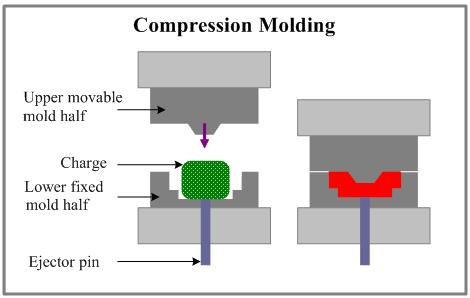Compression molding:
Compression molding is a method of molding in which the molding material, generally preheated, is first placed in an open, heated mold cavity. The mold is closed with a top force or plug member, pressure is applied to force the material into contact with all mold areas, while heat and pressure are maintained until the molding material has cured. The process employs thermosetting resin in a partially cured stage, either in the form of granules, putty-like masses, or preforms. Compression molding is a high-volume, high-pressure method suitable for molding complex, high-strength fiberglass reinforcements. Advanced composite thermoplastic can also be compression molded with unidirectional tapes, woven fabrics, randomly oriented fiber mat or chopped strand. The advantage of compression molding is its ability to mold large, fairly intricate parts. Also, it is one of the lowest cost molding methods compared with other methods such as transfer molding and injection molding; moreover it wastes relatively little material, giving it an advantage when working with expensive compounds. However, compression molding often provides poor product consistency and difficulty in controlling flashing, and it is not suitable for some types of parts. Fewer knit lines are produced and a smaller amount of fiber-length degradation is noticeable when compared to injection molding. Compression-molding is also suitable for ultra-large basic shape production in sizes beyond the capacity of extrusion techniques.
Torchmold had 9 years experiences for design and buliding Compression molding.
Torch mold technical design team consists of: plastic, mechanical, tooling, and aeronautical engineers. Whether a customer requires a complete mold design, reverse engineering, prototypes, or short run production parts, our team can design a mold to achieve the desired results, creating a unique opportunity for cost reduction and increasing speed to market by providing manufacturability insig


